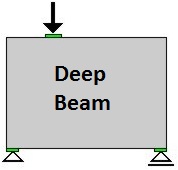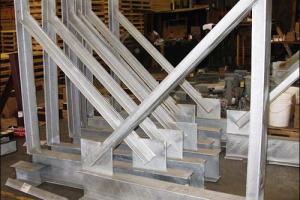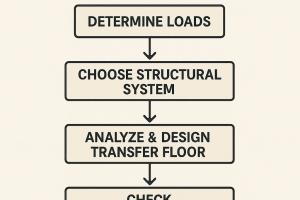What are Deep Beams? | Definition, Concept and Applications

Deep Beams Concept
Definition
Deep beams are structural elements loaded as simple beams in which a significant amount of the load is carried to the supports by a compression force combining the load and the reaction. As a result, the strain distribution is no longer considered linear, and the shear deformations become significant when compared to pure flexure.
Floor slabs under horizontal load, short-span beams carrying heavy loads, and transfer girders are examples of deep beams. A deep beam is a beam having a large depth/thickness ratio and shear span depth ratio of less than 2.5 for concentrated load and less than 5.0 for the distributed load. Because of the geometry of deep beams, their behavior is different from slender beams or intermediate beams.
Difference Between Deep Beams & Simple Beams
The followings are the major differences of  deep beam elements compared with simple beams based on the design assumption, as follows:
deep beam elements compared with simple beams based on the design assumption, as follows:
- Two-Dimensional Action, because of the dimension of the deep beam they behave as two-dimensional action rather than one-dimensional action.
- Plane Section Do Not Remain Plane, the assumption of the plane section remains plane cannot be used in the deep beam design. The strain distribution is no longer linear.
- Shear Deformation, the shear deformation cannot be neglected as in the ordinary beam. The stress distribution is not linear even in the elastic stage. At the ultimate limit state, the shape of the concrete compressive stress block is not parabolic shape again
The Design is based on the ACI Ultimate Strength Design Method and applies to those flexural members having a clear span-to-depth ratio of less than 4.0. The flexural reinforcement is designed taking into account the reduced lever arm due to the nonlinearity of the strains' distribution.
Engineering Applications of Deep Beams
Deep beams play a very significant role in the design of mega and as well as small structures. Sometimes for architectural purposes, buildings are designed without using any columns for a very large span. In such cases, if ordinary beams are provided they can cause failure such as flexural failure.
To avoid this problem of construction of some very long-span halls etc the concept of deep beams is very effective and durable.
Deep beams are commonly found in various engineering applications, including:
-
Transfer Beams: Deep beams are often utilized in buildings where there is a need to transfer loads from one area to another, such as transferring loads from walls to columns or from a column to a column. Transfer beams help distribute concentrated loads and prevent localized overloading.
-
Bridge Girders: Deep beams are employed as bridge girders to span over large distances and support the weight of vehicular loads. The increased depth of the beam allows for greater resistance to bending moments and shear forces, ensuring the structural integrity of the bridge.
-
Foundation Beams: Deep beams are used in foundation systems, particularly when there is a requirement to distribute heavy loads over a larger area or to bridge weak or unstable soil conditions. The increased depth aids in minimizing settlement and provides a more stable foundation.
-
Shear Walls: Deep beams are commonly incorporated as shear walls in buildings to resist lateral loads, such as wind or seismic forces. The increased depth of the beam helps to enhance its shear resistance, allowing for better structural stability.
The design of deep beams involves considering their unique behavior under load. Deep beams exhibit a different stress distribution pattern compared to regular beams due to their increased depth. They are more prone to shear failure rather than flexural failure. As a result, reinforcement detailing and shear reinforcement play a crucial role in ensuring the structural integrity of deep beams.
In summary, deep beams are structural members with a relatively large depth-to-span ratio. They are used in applications where there is a need for enhanced load-carrying capacity and resistance to bending moments. Deep beams find applications in transfer beams, bridge girders, foundation systems, and shear walls. Understanding their behavior and incorporating appropriate reinforcement detailing is vital in their design to ensure their strength and stability under various loading conditions.












